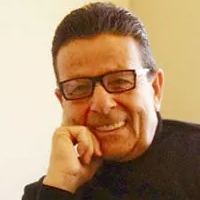Ikat above all others
She grew up in the walled city of Old Delhi, completed her studies, and became that archetypal housewife with two tinytots in tow. And then, she took stock of things. Her interest and passion for natural fibres steered her into the world of textiles. As one thing led to another, the craft-based fashion label and the designer herself became alter egos of each other. As she steps into her 30th year in the profession, Madhu Jain talks about weavers, ikat and the sojourn this far with Meher Castelino
Fibre2Fashion: You are celebrating 29 years in the profession. How have you survived for three decades?
Madhu Jain:
I consider myself lucky that my "profession" is also my passion. Like everyone else, I've had my ups and downs, but as a designer and craft revivalist and textile conservationist, what has kept me going is the visceral need for constant innovation in weaves, my work with master craftsmen, and the satisfaction of keeping buyers' interest alive in handlooms.
F2F: How did you start off? And, why did you choose textile designing?
MJ:
I'm a true-blue Dilliwalli, and my early growing-up years were in the walled city. I still have a strong connect with the old-world architecture, atmosphere, colours, and food of Old Delhi, and appreciate that my initial years there have shaped who I am today. I schooled at the Convent of Jesus and Mary, did a BA in Sociology from Jesus and Mary College, then joined the Delhi School of Economics for an MA in Sociology. In 1982 I got married to my school sweetheart, whom I met at the socials. Married into a typical conservative Jain family, I had two kids in quick succession, and was a housewife till 1987, when I took stock of my life. I wanted to carve a career for myself, to professionalise my interest in natural fibres and fashion design. Thus was born the Madhu Jain craft-based fashion label. My high comes from working at the grassroots in India's villages with master weavers and artisans, and designing new textiles.
F2F: As a designer what are the hurdles that you still face?
MJ:
While I have worked successfully with the textiles department of the Government of India, I wish that there was a deeper understanding of textiles and aesthetics within the relevant government departments. This sector sorely needs a shot in the arm with an infusion of funding and R&D interventions. We need to develop a sensitivity and far-sightedness that will save our precious arts and crafts sector from dying out. And it is only the government that has the bandwidth to effect largescale change in this sector.
F2F: Which has been your most successful collection in the 29 years?
MJ:
This is like asking a mother who her favourite child is! Each one of my collections has been dear to my heart because of the intense innovation that goes into developing my textiles. I work both at the production and design intervention ends, and the process is an extremely time-consuming, nail-biting one. The high one finally gets in fashioning the perfect textile is reward in itself.
F2F: How often do you bring out a collection with different weaves? Which will be the next?
MJ:
I like to bring out a collection every season. I have long been fascinated by the breath-taking and highly intricate murals and frescos in the temples of Kerala's Guruvayur complex, which bring alive Hindu mythology. I am trying to incorporate some motifs from these temples into my Spring 2017 collection.
F2F: Which are your favourite weaves that you have enjoyed working with?
MJ:
I'm currently totally into ikat. Another favourite weave that I thoroughly enjoyed working with was uppada of the West Godavari region of Andhra Pradesh.
F2F: Which is more interesting for you- making saris, or turning the fabrics into garments?
MJ:
My forte lies in making my own range of hand-crafted textiles. I don't go out and source from what's available in the market. So, for me it's the textile that is the most relevant part of the production process. If you think about it, a sari is nothing but six yards of gorgeous textile. I love turning the textile into garments simply because the weaves I come up with are determined by the kind of outfits I want to fashion them into. The thread count, the yarn itself, and the design are all carefully taken into consideration before the weaving process.
F2F: Ikat thrives across many nations. How different is the ikat in India as compared to that in Indonesia or some other countries, or for that matter what is practised in Southern India and Odisha or Gujarat?
MJ:
Ikat is one of the most ancient weaving techniques, and is found in many regions, having probably (as per scholarly reports) originated in each area independently. The ikats of Central Asia, Southeast Asia, Africa, Japan, and Central and South America are well-known. While you'll find regional variations in the design, the "blurriness" of the weave remains a constant due to the extremely tough resist-dyeing technique that characterises it, which weavers take years to perfect. Ikats across the globe play around with three types-the warp ikat, the weft ikat, and the double ikat. The last is the most difficult to render as resists are tied to both the warp and the weft before dyeing, and this weaving form can be found only in four countries-India, Indonesia, Japan and Guatemala. The Indian states that specialise in this ancient weave are Odisha, Andhra Pradesh, Telengana and Gujarat. In Uzbekistan, ikat was traditionally worn by royalty or the very rich. For this Uzbek-inspired ikat collection, I drew from both the Adrasa and Atlas forms of Uzbeki weaves. Since the latter weave uses only silk, I relied mainly on the adrasa weave, which incorporates both a cotton weft and a silk warp. Merging the traditional Uzbeki weave with the Indian ikat was a challenge, and it took months of painstaking research and weaving to get the convergence just right.
F2F: What is the aftercare for ikat weaves that you would recommend?
MJ:
Ikats are forever, and don't get spoiled. They're easy maintenance, but I'd recommend dry cleaning as that keeps clothes and textiles fresh and looking new.
F2F: What are the other weaves besides ikat that you have worked with?
MJ:
Because of my proclivity towards natural fibres that are indigenous in ethos and execution, I have had the privilege of working with Government of India's ministry of textiles on two major projects. I introduced bamboo fabric in India in 2003 as an alternative, eco-friendly textile, and showcased my textiles and outfits at the 7th Bamboo Congress in 2004 for which I was conferred FICCI's Award of Excellence in 2009 in the field of creative arts. I've successfully woven bamboo with khadi, chanderi, and wool. I also breathed fresh life into srikalahasti kalamkari, which uses a pen (kalam) to draw and colour motifs freehand. For this, I wove special cotton that would best reflect the depth of colour of the organic dyes. It was extremely rewarding to be invited to craft for the opening ceremony of the 2010 Commonwealth Games in the "Fabric of India" segment. Using the skills of 300 weavers, 500 craftsmen and 200 hand embroidery artisans, I designed and executed a giant 115-feet eco-friendly craft installation using bamboo fibre and kalamkari. I've also worked hard to reintroduce Dhaka muslin-a cotton textile of hand-spun yarn requiring extreme delicacy and expertise into India and since 1996, it has taken off in India's mainstream fashion world. I've also worked on the Assamese mekhela-chaddar, and Andhra uppada.
F2F: But, how knowledgeable is the Indian buyer about the various weaves in India, and about ikat?
MJ:
Because of factory-produced fabrics, the handloom sector has taken a beating. The price factor is the most significant, as these mass-produced fabrics are far cheaper than handlooms. Sadly, the indigenous textiles sector is endangered today because of the lack of substantial buyers who can guarantee weavers' livelihoods. But I'm relieved that there is a small section that appreciates what the natural textiles industry has to offer, and who value our traditional weaves. My humble attempt is to keep buyers' interest alive in handlooms and to grow that space. We cannot let a 2,000-year-old tradition die out.
F2F: So, can westernwear make deeper inroads into Indian fashion, and push traditional weaves away?
MJ:
Fortunately for traditional handlooms industry, westernwear and Indian weaves are not mutually exclusive. Any traditional Indian weave can be cut, draped or layered into any type of western or fusion-wear silhouette. The richness of our weaves has always attracted international designers-from Oscar de la Renta to Jean-Paul Gaultier, Giorgio Armani, Ralph Lauren, Yves St Laurent, and Calvin Klein, to name a few. Tunics, classic shirts, pants, different length dresses, skirts, shorts… all these have incorporated Indian textiles and crafts, even infusing their creations with the strong Indian colour palette. Designers in India too are crafting different silhouettes, which have both a pan-India and global appeal.
F2F: With more women going in for westernwear, how do you see the future of traditional Indian dresses?
MJ:
The beauty of "traditional" Indian clothes is their constant adaptability to changing trends. A sari can be worn in a hundred different ways, playing with drape, texture, mix-and-match blouses. But in the end, you'll recognise the silhouette as a sari, even if worn with tapered trousers. The same goes for the salwar-kameez, which has morphed into loose pants worn over a long kurta, palazzos with cropped tops, tights under an anarkali, or just a long or short tapered kurta worn as a dress. And don't forget, the mekhela from Assam, the half-saree from South India, and ghagras and lehengas, are all long skirts.
F2F: On an overall note, how do you see the future of traditional crafts in India?
MJ:
There is constant innovation in factory-produced goods, and the textiles and crafts section is no exception. The earthenware "matka" has given way to plastic mugs, hemp ropes are being replaced by nylon strings, and organic, natural textiles are facing stiff competition from synthetic fabrics. To safeguard against getting edged out, the traditional textiles sector needs to build on its core strengths. However, this can only happen if government departments responsible for Indian textiles, handlooms and khadi could invest in the sector in a strategic fashion. I would be very happy to work in convergence with the government to infuse fresh life into a sector that might otherwise suffer a steady decline.


20230103183907.png)

_8.JPG)








